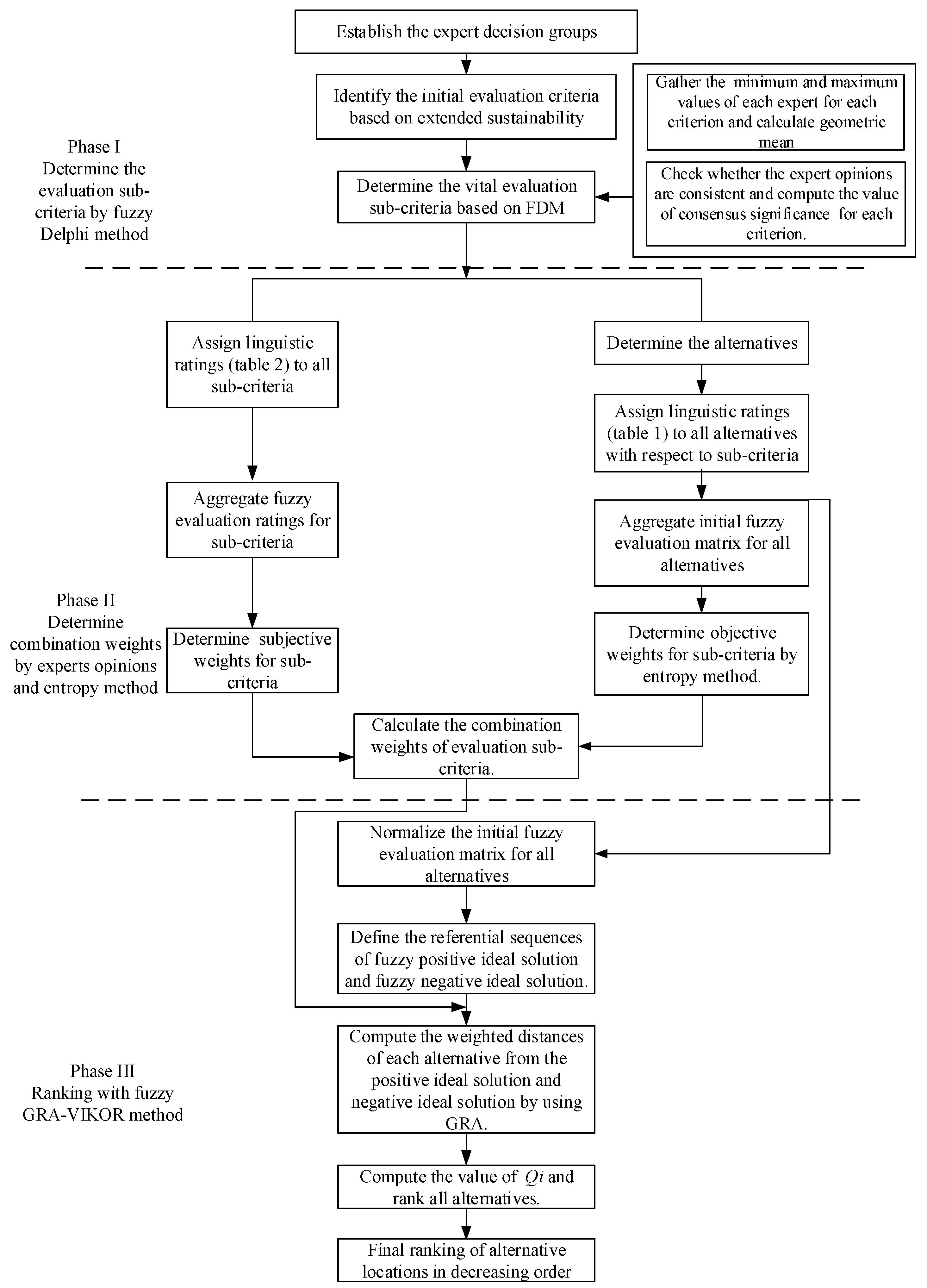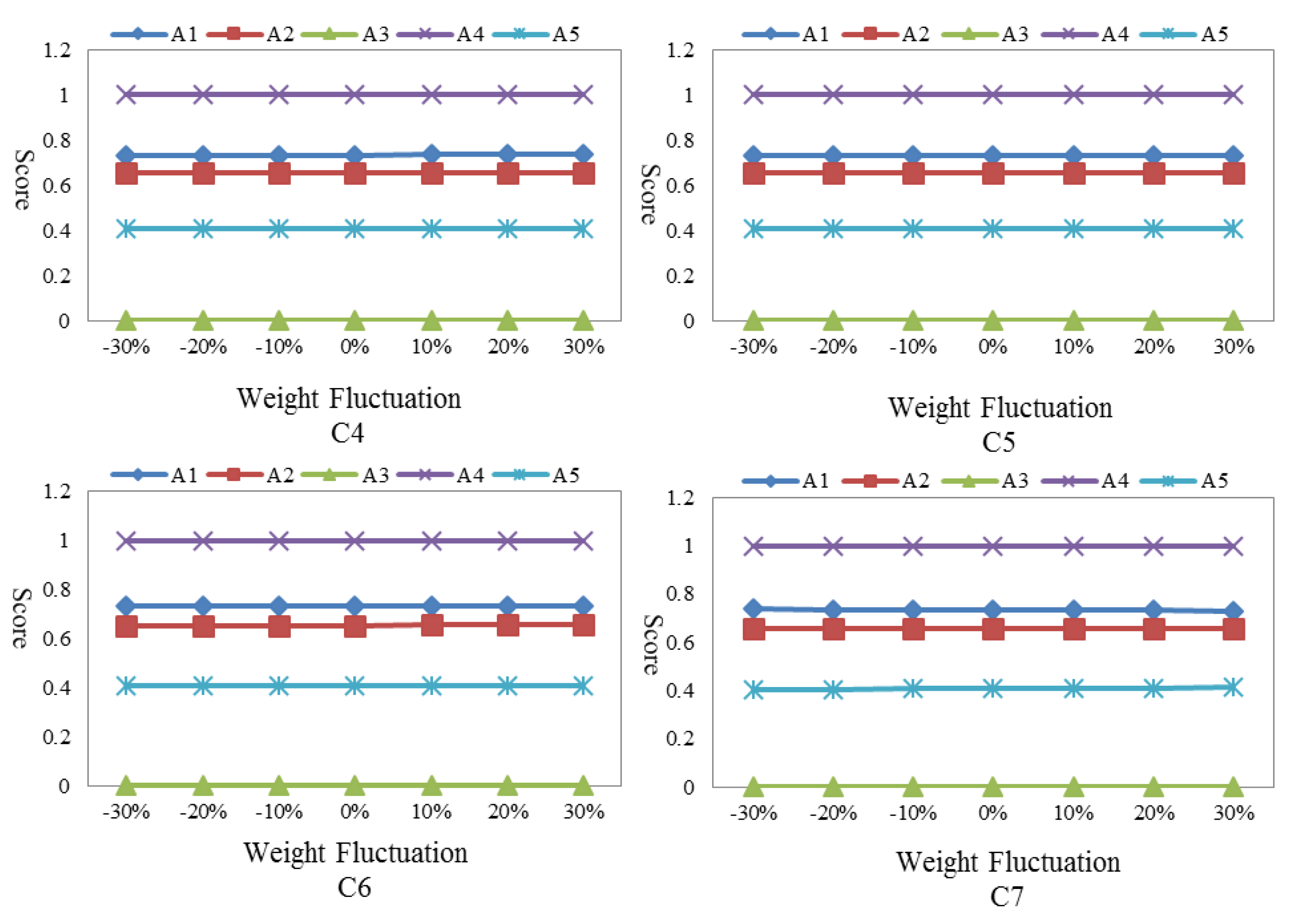3.1. Fuzzy Logic
Fuzzy theory, proposed by Zadeh in 1965, is used to map linguistic terms to numerical terms within human decisions. The fuzzy set is often defined to solve the uncertainty and vagueness in criteria weighting and alternatives ratings of multi-criteria decision making problems [
39]. A fuzzy set, featured by a membership function, assigns each criterion a membership rating among (0, 1), reflects criteria grades belonging to a set. In addition, linguistic terms such as “good”, “fair” and “bad” are put forward to define numerical intervals [
40].
A triangular fuzzy number
, denoted by (
a,b,c), is the most popular fuzzy number in fuzzy applications [
41]. The membership function is defined as follows:
and –∞ <
a ≤
x ≤
b < ∞.
In concrete terms, the membership function
indicates that variable
x fully belongs to the fuzzy set
. Conversely, if the variable
x does not belong to the fuzzy set
, then
[
42].
Let
and
be two triangular fuzzy numbers, the operation laws are shown as below:
And the distance of
and
can be defined as follows [
43]:
In most MCDM processes, decision makers often provide uncertain answers rather than precise values. Linguistic values and fuzzy set theory are recommended to rate preference instead of traditional numerical method. Therefore, the fuzzy set theory has been integrated into various MCDM methods, such as fuzzy AHP, fuzzy TOPSIS, fuzzy VIKOR, and so on, which should be more appropriate and effective than conventional ones in real problems involving uncertainty and vagueness [
44,
45,
46].
3.2. Fuzzy Delphi Method
The Delphi method (DM) is a technique used to obtain the most reliable consensus among a group of experts. It was proposed by Dalky and Helmer in 1963 and has been widely used in decision and prediction making. This technique offers experts opportunities to receive feedback and modify previous opinions through several rounds of consulting. Furthermore, owning to its deficiency in handling ambiguity and uncertainty within expert surveys, fuzzy Delphi method (FDM) was proposed to solve these defects combing DM with fuzzy logic theory. Experts can provide their opinions through triangular fuzzy numbers (TFNs), and are not required to modify them again and again. Moreover, no useful information would be lost, because all opinions can be effectively taken into account by the membership degrees. Due to its advantages in evoking group decisions, FDM is embraced in various studies to construct evaluation. To recognize the vital criteria for the optimal siting of EVCS, the FDM is introduced in this paper. Essential steps of the FDM are listed as follows:
Step 1: Administer questionnaires and determine the most conservative value and the most optimistic value ranging from 0 to 10 for each criterion among a group of experts.
Step 2: Gather the minimum and maximum values and calculate the geometric mean for each criterion. Then, compute the conservative TFN () and optimistic TFN () in terms of each criterion. and represent the minimum remaining conservative value and minimum remaining optimistic value, respectively; and represent the maximum remaining conservative value and maximum remaining optimistic value, respectively; and and represent the geometric mean of the remaining conservative value and the geometric mean of the remaining optimistic value, respectively.
Step 3: Check that the consistency of expert opinions, and compute the consensus significance Gi for each criterion.
- (1)
If
, the criterion
i holds consensus, and the value of the consensus significance
Gi is computed by Equation (7):
- (2)
If
, and the gray zone interval value (
) is smaller than the interval value
, correspondingly, the value of the consensus significance is computed by Equation (2):
When , however, the gray zone interval value () is greater than the interval value (), which means that the expert opinions are inconsistent. Thus, Steps 1–3 should be repeated until each criterion converges and the value of the consensus significance can be calculated.
3.3. Fuzzy GRA-VIKOR Method
The Vlsekriterijumska Optimizacijia I Kompromisno Resenje (VIKOR) method, put forward by Opricovic in 1998, was developed for multi-criteria optimization of complex systems. This model focuses on ranking different alternatives against various even conflicting decision criteria. It relies on an aggregating function that can reflect distance to both positive and negative ideal points [
47]. In order to handle the imprecision and subjectivity of decision makers, linguistic values are introduced into the conventional VIKOR. The fuzzy VIKOR combines the advantages of the conventional VIKOR and fuzzy set theory, which is much more sufficient to model problems in the real world than precise values [
12,
13,
14,
48,
49].
In fuzzy VIKOR, the multi-criteria measurement process for ranking alternatives is developed from an aggregating function, which represents the distance of each alternative from positive ideal point and negative ideal point. As mentioned in the introduction, in order to better examine the extent of the connection between alternative and ideal points, grey relation analysis is used to modify the conventional aggregating function, which can better identify relationships among fuzzy numbers in a system [
15,
16]. Moreover, the fuzzy VIKOR based on GRA method can efficiently overcome the deficiencies of fuzzy results and the inconsistent ranking of alternatives [
17,
18]. More details of this approach are shown as below:
Here, the ratings of criteria are expressed in linguistic terms (the triangular fuzzy numbers), as in
Table 1.
Step 1. Calculate the aggregated fuzzy linguistic ratings for criteria performance of alternatives.
Suppose that there are m alternatives A = {A1,A2,…Am} to be evaluated. The performance of n criteria are by linguistic terms which are obtained from r decision makers.
Let
,
be the linguistic rating on the performance criteria
Cj respect to alternative
Ai by expert
Ek. Then the aggregated fuzzy linguistic rating
can be obtained as follows:
Step 2. Assemble the initial fuzzy decision matrix.
According to Equation (9), the initial fuzzy decision matrix
can be obtained, as shown in Equation (10). A MCDM problem can be expressed concisely in the form of triangular fuzzy number, as follows:
Step 3. Normalize the initial fuzzy decision matrix using linear scale transformation.
To ensure the compatibility among evaluation criteria, the initial fuzzy decision matrix should be transformed into a comparable scale. The normalized fuzzy decision matrix is denoted by
[
50]:
For the benefit criteria:
Step 4. Define the referential sequences of fuzzy positive ideal solution and negative ideal solution.
The referential sequences of positive ideal solution
A+ and negative ideal solution
A– can be determined as follows:
where
,
,
j = 1,2,…
nStep 5: Compute the distances of each alternative from the positive ideal solution and negative ideal solution [
51].
where
wj represents the weight of criteria
Cj,
denotes the distance rate of
Ai to the positive ideal solution
A+, and
denotes the distance rate of
Ai to the negative ideal solution
A–.
In order to better reflect distance of each alternative to the positive and negative ideal points, the fuzzy grey relation coefficient (FGRC) is introduced to modify the conventional formula of fuzzy VIKOR, which are shown as follows [
16]:
Step 6: Compute the value of
Qi for each alternative as below:
where
S+ = max
iSi,
S– = min
iSi,
R+ = max
iRi,
R– = min
iRi, and
v is the weight of the strategy of “the maximum group utility”, whereas (1–
v) represents the weight of the individual regret.
Step 7: Rank the alternatives according to the value of Qi in Step 5.
On the basis of the concepts of GRA and fuzzy VIKOR method, all alternatives can be ranked by the value of Qi. Obviously, for the alternative Ai which is closer to the positive ideal point and farther from the negative ideal point, the value of Qi is zero.
In addition, only when the alternative which is the best ranked by the value of Qi satisfies the following conditions, it can be selected as the optimal solution.
- (I)
Acceptable advantage:
where
A(2) is the second in the list of priorities by
Qi;
DQ = 1/(
N–1),
N is the number of alternatives [
51].
- (II)
Acceptable stability in decision-making:
The alternative
A(1) must also be the best ranked by
or
Ri. This compromise solution is stable within the decision-making process, which could be the strategy of maximum group utility (when
v > 0.5 is needed), or “by consensus” (
v ≈ 0.5), or “with veto” (
v < 0.5). If one of the conditions is not satisfied, then the set of solutions is proposed [
16], which consists of:
A(1) and A(2), if only the condition (II) is not satisfied, or
A(1),A(2),A(3),…A(M), if the condition (II) is not satisfied; A(M) is determined by the relation Q(A(M) – A(1)) < DQ, for maximum M (the positions of these alternatives are “in closeness”).
3.4. The Combination Weights
The weighted sum of the “distances” from an alternative to corresponding ideal points over all criteria is essential for performance comparison among all designated alternatives. From the previous literature on MCDM, the weights of criteria are usually subjective weights determined by decision makers. However, critiques of human errors and inconsistency are often associated with subjective weights for such weighting processes in MCDM. With this regard, to improve the weighting accuracy, some objective weighting models are applied by mathematical techniques. To obtain a better weight determining system for fuzzy VIKOR, combination weights based on subjective methods and objective methods are introduced in this study, which can composite subjective judgment and objective information. On the one hand, the subjective weights are determined by experts’ opinions. On the other hand, the objective weights are obtained by the Shannon entropy method.
3.4.1. The Subjective Weights
On the one hand, the subjective weights could be obtained from experts’ opinions. Here, the ratings of criteria are expressed in linguistic terms (the triangular fuzzy numbers), as in
Table 2.
Let
,
be the superiority linguistic rating on criteria weight assigned to criteria
Cj by expert
Dk can be calculated by:
In order to maintain the consistency between objective weights and subjective weights, the criteria weights based on triangular fuzzy numbers should be also defuzzied based on Equation (21). In this paper, the graded mean integration approach is employed to transform a triangular fuzzy number
M = (
l,m,u) into a precise number:
3.4.2. Shannon Entropy and Objective Weights
The entropy concept proposed by Shannon in 1948 is a measure of uncertainty in formulated information, which has been widely used in many fields such as management, engineering and so on. According to the ideal of entropy theory, the number or quality of information from decision-making process is determined by the accuracy and reliability of the decision-making problem [
52]. Therefore, entropy can be applied to the assessment problem in different decision-making processes. Moreover, entropy can also be used to analyze the quantity of information provided by data [
53]. The basic theory and specific steps of Shannon entropy weighting method are shown as below:
Shannon entropy is capable of evaluating the decision making units and being employed as a weighting decision method. Assume that a MCDM problem contains
m alternatives and
n criteria, thus the decision making matrix is defined as below:
Then, the criteria weights can be determined based on the entropy concept through the following steps:
Step 1: Normalize the evaluation criteria as below:
Specially, for the fuzzy MCDM problem, the fuzzy decision making matrix should be defuzzyed firstly, according to Equation (21).
Step 2: Calculate the entropy measure of each criterion as [
51]:
where
k = (ln(
m))
–1.
Step 3: Define the divergence of each criterion through:
The more the divj is, the more important the jth criterion is.
Step 4: Determined the normalized weights of all criteria through [
54]:
Finally, the combination weights of all criteria are equal to the average of subjective and objective weights.














